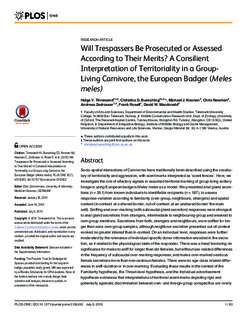| dc.contributor.author | Tinnesand, Helga Veronica | |
| dc.contributor.author | Buesching, Christina D. | |
| dc.contributor.author | Noonan, Michael J. | |
| dc.contributor.author | Newman, Chris | |
| dc.contributor.author | Zedrosser, Andreas | |
| dc.contributor.author | Rosell, Frank | |
| dc.contributor.author | Macdonald, David W. | |
| dc.date.accessioned | 2015-08-13T14:11:39Z | |
| dc.date.accessioned | 2017-04-19T12:24:25Z | |
| dc.date.available | 2015-08-13T14:11:39Z | |
| dc.date.available | 2017-04-19T12:24:25Z | |
| dc.date.issued | 2015-07-06 | |
| dc.identifier.citation | Tinnesand, H.V., Buesching, C.D., Noonan, M.J., Newman, C., Zedrosser, A., Rosell, F. & Macdonald, D.W. Will Trespassers Be Prosecuted or Assessed According to Their Merits? A Consilient Interpretation of Territoriality in a Group-Living Carnivore, the European Badger (Meles meles). PLoS ONE. 2015, 10(7): e0132432 | |
| dc.identifier.issn | 1932-6203 | |
| dc.identifier.uri | http://hdl.handle.net/11250/2437935 | |
| dc.description.abstract | Socio-spatial interactions of Carnivores have traditionally been described using the vocabulary of territoriality and aggression, with scent marks interpreted as ‘scent fences’. Here, we investigate the role of olfactory signals in assumed territorial marking of group-living solitary foragers using European badgers Meles meles as a model. We presented anal gland secretions (n = 351) from known individuals to identifiable recipients (n = 187), to assess response-variation according to familiarity (own-group, neighbours, strangers) and spatial context (in-context: at a shared border; out-of-context: at an unshared border/ the main sett). Sniffing and over-marking (with subcaudal gland secretion) responses were strongest to anal gland secretions from strangers, intermediate to neighbouring-group and weakest to own-group members. Secretions from both, strangers and neighbours, were sniffed for longer than were own-group samples, although neighbour-secretion presented out-of-context evoked no greater interest than in-context. On an individual level, responses were further moderated by the relevance of individual-specific donor information encoded in the secretion, as it related to the physiological state of the responder. There was a trend bordering on significance for males to sniff for longer than did females, but without sex-related differences in the frequency of subcaudal over-marking responses, and males over-marked oestrous female secretions more than non-oestrous females. There were no age-class related differences in sniff-duration or in over-marking. Evaluating these results in the context of the Familiarity hypothesis, the Threat-level hypothesis, and the Individual advertisement hypothesis evidences that interpretations of territorial scent-marks depicting rigid and potentially agonistic discrimination between own- and foreign-group conspecifics are overly simplistic. We use our findings to advance conceptual understanding of badger socio-spatial ecology, and the general context of territoriality and group-range dynamics. | |
| dc.language.iso | eng | |
| dc.publisher | PLoS | |
| dc.rights.uri | http://creativecommons.org/licenses/by/4.0/ | |
| dc.subject | badger | |
| dc.subject | Meles meles | |
| dc.subject | territoriality | |
| dc.subject | scent marking | |
| dc.subject | behavioural ecology | |
| dc.title | Will Trespassers Be Prosecuted or Assessed According to Their Merits? A Consilient Interpretation of Territoriality in a Group-Living Carnivore, the European Badger (Meles meles) | |
| dc.type | Journal article | |
| dc.type | Peer reviewed | |
| dc.description.version | Published version | |
| dc.rights.holder | © 2015 Tinnesand et al. | |
| dc.subject.nsi | 480 | |
| dc.identifier.doi | http://dx.doi.org/10.1371/journal.pone.0132432 | |

